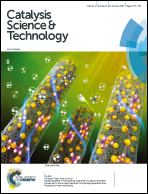Deep insight into the structure–activity relationship of Nb modified SnO2–CeO2 catalysts for low-temperature selective catalytic reduction of NO by NH3†
Abstract
Nb modified SnO2–CeO2 catalysts were synthesized via a co-precipitation method and used for selective catalytic reduction of NO with NH3 (NH3-SCR). After modifying the niobium oxides, the NH3-SCR activity of the SnO2–CeO2 catalyst is greatly promoted in the temperature range of 120–210 °C and the H2O tolerance of the catalyst is also improved in the long term operation. It is demonstrated that there is a strong interaction among Nb, Sn and Ce cations in the Nb modified SnO2–CeO2 catalyst. Moreover, H2-TPR, O2-TPD, XPS analysis and DFT calculations prove that Nb modified SnO2–CeO2 catalysts could provide more positive electronic charge and active electron orbits, which give rise to the varied adsorption behavior of the NH3 species and NOx species. Consequently, the reaction mechanism of SnO2–CeO2 catalysts might change after Nb modification. In situ DRIFTS was also employed to evaluate the reactivity of NH3 with NOx species over SnO2–CeO2 catalysts and Nb modified SnO2–CeO2 catalysts, respectively. NH3-SCR reaction over the SnO2–CeO2 catalyst follows both the Eley–Rideal mechanism and the Langmuir–Hinshelwood mechanism. In view of the Nb modified SnO2–CeO2 catalyst, its reaction mainly follows the changed E–R mechanism, where abundant active coordinated NH3 species are preferable to be activated to amide species (NH2) and thereafter quickly react with gaseous NO to generate N2 and H2O. Additionally, Nb contributed to the generation of oxygen vacancies to capture the active O2 species, leading to the enrichment of the catalytic cycle. Accordingly, the catalytic pathway of the SnO2–CeO2 catalyst is greatly optimized after the modification of Nb. Finally, the structure–activity relationship of the SnO2–CeO2 catalyst and Nb modified SnO2–CeO2 catalyst is also established. Deep insight into the structure–activity relationship of the Nb modified SnO2–CeO2 mixed oxide catalysts paves the way for a better understanding of the mechanistic aspect of Ce-based catalysts, which is helpful for developing highly efficient Ce-based catalysts for practical applications.



 Please wait while we load your content...
Please wait while we load your content...